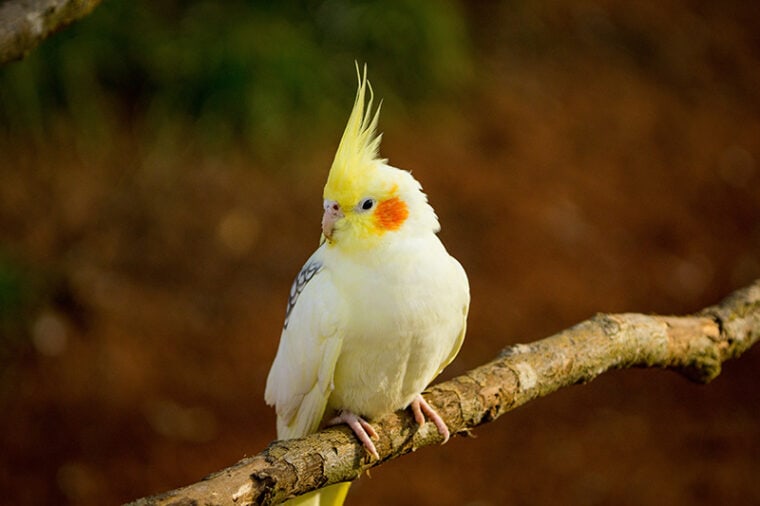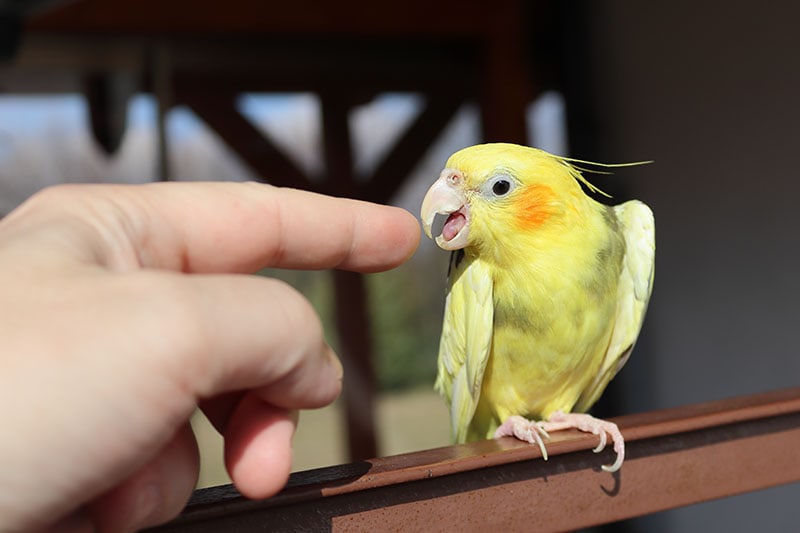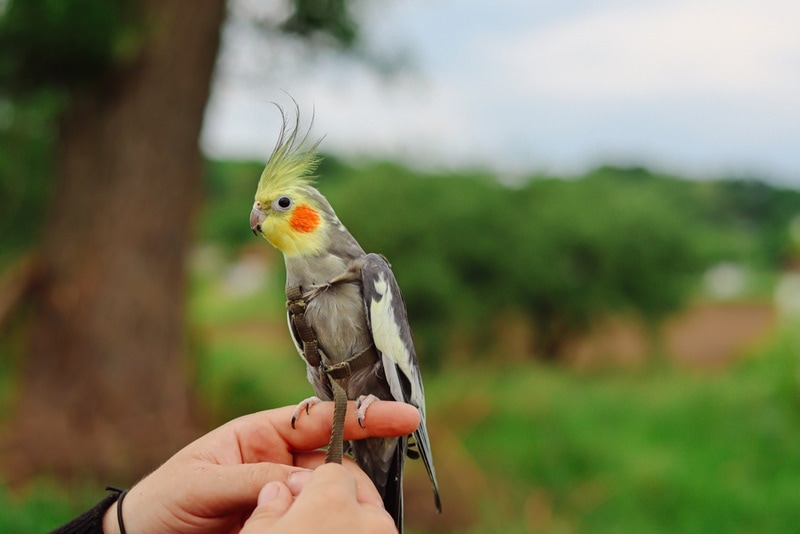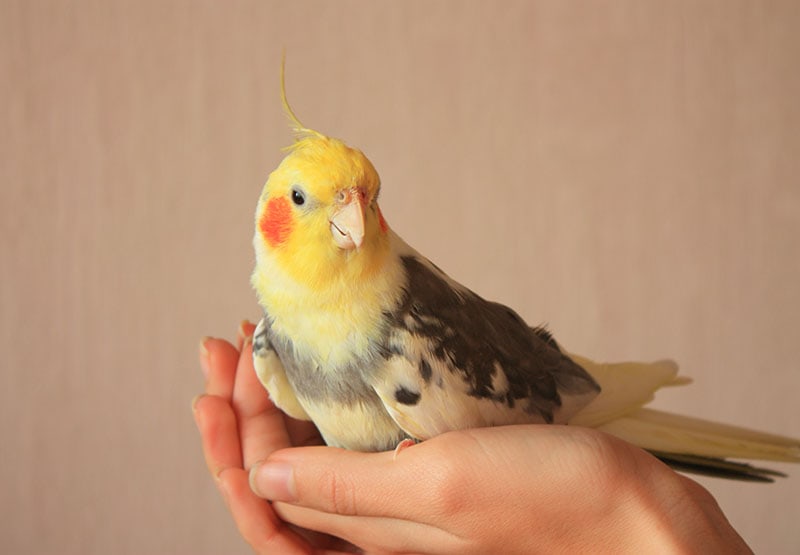
Click to Skip Ahead
If you’re a first-time cockatiel owner, you may not realize that one of your responsibilities as a bird parent is trimming your pet’s nails. While your cockatiel can file his nails a bit if you provide the right type of perches in his cage, you can’t overlook the importance of trims. Not only will a nail trim protect your skin, as bird nails can get razor sharp, but it will keep your cockatiel safe, too.
We recommend having the nails trimmed initially by a veterinarian until you feel comfortable with how to do it.
Keep reading to learn how to trim your cockatiel’s nails and live to tell the tale.
Before You Start: Gather Your Supplies
The supplies you’ll need for trimming cockatiel nails are:
The 7 Steps for How to Trim Cockatiel Nails
1. Inspect the Nails
Once your supplies are gathered and all within reach, allow your bird to leave its cage. Hold him in one hand and check his nails with your free hand.

2. Wrap Your Cockatiel in a Towel
Drape the towel over your bird’s back, leaving his head uncovered. Hold him firmly at his sides, but do not press against his chest. Birds don’t have diaphragms, and too much pressure on the chest can cause suffocation.
It’s unlikely that your cockatiel will like this stage, so you’ll need to restrain his head in one hand to ensure you don’t get bit. Place your index (pointer) finger on one side of its head and your middle finger on the other. Hold the head firmly enough that he can’t turn his head freely but be careful not to cause injury.
3. Find the Quick
Cockatiel nails have a blood vessel inside known as the quick. You need to avoid cutting the quick. Hold his feet before your light source to help you determine where this blood vessel is.
If your bird’s nails are pale, it should be easy to see the blood vessels as the pink area in the nail’s center. If his nails are dark, you’ll need to proceed carefully and trim only a small bit.
4. Speak Softly & Calmly
Being held for long periods against his will is likely to stress out your cockatiel, so speak calmly to him throughout the process. Additionally, be prepared to work as fast as you can to avoid keeping him in this awkward and stressful situation. You may need to only do a couple of nails at a time and come back to it another day.

5. Snip the Tip
Carefully snip off the tip of the nail at a 30-degree forward-sloping angle toward your cockatiel’s foot. If you cannot see the quick, don’t clip off more than 1/16 of an inch. It’s better to be safe than sorry about this. Though it may seem minor, snipping the quick can cause heavy bleeding. Birds can die from this kind of injury if it’s not handled properly or fast enough. This is why we recommend having the styptic powder on hand and familiarizing yourself with how to use it properly well before the need to use it ever arises.
6. Know When to Stop
You can expect your cockatiel to express his unhappiness about his nail trim in some capacity, but if he appears to be having difficulty breathing or is moving too much for you to keep a firm hold on him, stop and put him back in his cage. You can try again once he’s had time to calm down.
Nail trims can be stressful for you and your cockatiel and sadly birds are susceptible to dying due to stress. If either of you isn’t up to the task, it’s best to leave the job for the professionals. You can take your pet to a skilled veterinarian or bird groomer who can do it for you.
7. Offer Praise & Treats
Offer plenty of praise and treats after your cockatiel’s nail trim so it can associate the experience with something positive. This will help you in the future when it’s time to do the next trim, as your bird may be less afraid if it knows it’ll get a treat at the end.
Ideally your bird would be trained to be accepting of nail trims before you need to do it. Spend time training them to be relaxed about having their feet handled and associating the nail clippers with treats.

What If My Bird Starts Bleeding?
As difficult as it may be, you must stay calm if you accidentally snip the quick and your cockatiel starts bleeding. The quick can bleed profusely, and it can be difficult to stop the blood flow, however most of the time it is not this bad.
Using a Q-tip, dab some styptic powder on the wound. It should clot and stop bleeding quickly. Alternatively hold a cotton pad on the nail for as long as your bird will tolerate. It may take a minute for the wound to clot. However, if the bleeding does not stop, you need to get your bird to the vet immediately.
Since cockatiels preen their feet and inevitably ingest whatever is on the surface of their nails, clotting agents like styptic powder should eventually be washed off after the bleeding has stopped.

Why You Need to Trim Your Cockatiel’s Nails
You never hear of a bird in the wild needing its nails trimmed, so you might wonder why you should be trimming your cockatiel’s nails in the first place.
Birds in the wild don’t have anyone trimming their nails because they get filed naturally. Every time a bird walks or lands on rough surfaces, its nails get filed.
You need to trim your pet’s nails because companion birds generally don’t have the same access to varied rough surfaces as their wild counterparts. Additionally, overgrown nails are hazardous as they can curl round and become infected or can get snagged on cage bars, perches, toys, and pretty much any other surface your bird encounters. This can result in nails breaking or, worse, being ripped off entirely.
Final Thoughts
Trimming your cockatiel’s nails for the first time can be extremely stressful, especially when you factor in the possibility of cutting the quick. Our step-by-step guide should help you with the process, but it’s best to let a professional handle the job if you’re not feeling up to the task. Bird groomers and vets are experienced with nail trims and can have your cockatiel in and out in just a few minutes.
Read Also:
- Cockatiel Bird: Pictures, Traits, Facts & Care Guide
- Do Cockatiels Make Great Pets? Avian Facts & FAQs
Featured Image Credit: Marlon Roth, Shutterstock









